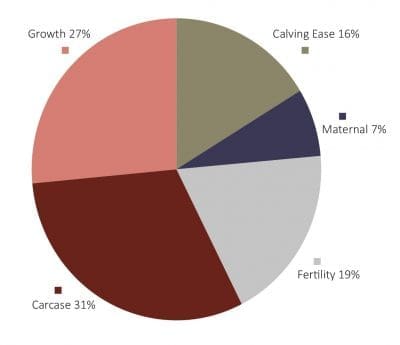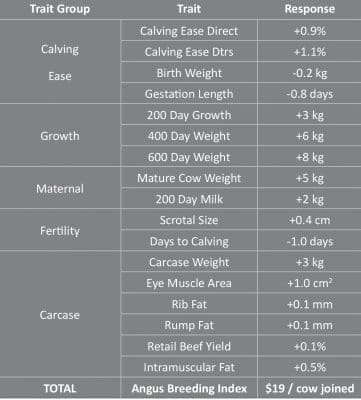Angus bulls being offered for sale this spring are being presented with a range of information that assists bull buyers in making an informed decision and purchasing the bulls that are most suitable for their beef breeding enterprise.
One such piece of information is the Angus Breeding Index.
An Angus Breeding Index is calculated for each animal within the Angus BreedPlan genetic evaluation and estimates the genetic differences between animals in net profitability per cow joined in a typical commercial self-replacing herd using Angus bulls.
This selection index is not specific to a particular production system or market end-point, but identifies animals that will improve overall profitability in the majority of commercial grass and grain finishing beef production systems.
The Angus Breeding Index is particularly suited to commercial producers who sell progeny into different markets (or to seedstock producers supplying bulls to commercial clients who produce for a range of different production systems and market end points).
The index assists in making ‘balanced’ selection decisions, taking into account the relevant growth, carcase and fertility attributes of each animal to identify animals that are most suitable for use within a typical self-replacing Angus breeding operation.
Trait Emphasis
The pie chart published here shows the emphasis that has been placed on each trait group in the Angus Breeding Index.

Response to Selection
The table published below shows the indicative change in traits after one generation if producers select animals using the Angus Breeding Index.

The indicative response reflects the change if the Angus Published Sires (at the November 2014 Angus Group BreedPlan analysis) were ranked on this selection index and the Top 10pc selected for use within a breeding program. The response will differ if a different group of animals was available for selection and/or a different selection intensity was applied.
Using the Angus Breeding Index in Selection
The Angus Breeding Index can be used to rank animals based on their overall genetic value within a typical self-replacing Angus breeding operation.
Additionally the index can be used to benchmark where an animal ranks compared to other animals analysed within the Angus BreedPlan analysis by comparing its selection index value to the current breed average value and to the percentile bands table.
Reference tables for Angus BreedPlan (i.e. current breed average and percentile bands) can be accessed from the Angus Australia website, or are usually provided in most bull sale catalogues.
Consider Individual EBVs
When using the Angus Breeding Index, it is important to pay attention to each animal’s Estimated Breeding Values for traits of particular importance in the individual breeding program.
For example, producers may pay attention to:
- Calving Ease EBVs if planning to use the bull over heifers
- Mature Cow Weight EBVs if monitoring the weight of mature cows is of particular importance
- Fat EBVs if more or less fat is required on steers at slaughter
- EMA EBVs if specifically wanting to improve the muscling in a herd
One simple way of considering an animal’s individual EBVs, is to set acceptable ranges for the individual EBVs of particular importance. In this scenario, animals would firstly be ranked on the Angus Breeding Index but then any animal whose individual EBVs fall outside of the acceptable range be excluded from selection.
It is also important to note that not all EBVs are currently included in the calculation of the Angus Breeding Index. For example, Net Feed Intake, Docility and Structural Soundness EBVs are currently excluded. In a similar vein to that outlined above, if these EBVs are of importance then animals should firstly be ranked on the Angus Breeding Index but then any animal whose EBV falls outside of an acceptable range for these traits be excluded from selection.
Consider Other Selection Criteria
In addition to consideration of individual EBVs, it is also important to consider other selection criteria that may not be accounted for in the calculation of the Angus Breeding Index.
For example, this may include such things as assessment of an animal’s temperament, structural soundness, phenotype, fertility status, carrier status for any relevant genetic disorders, pedigree and DNA results for qualitative traits like coat colour.
One strategy that can be used to incorporate selection for these other traits of economic and functional importance with the animal’s EBV and selection index information is to firstly rank animals on the index, exclude any animals whose individual EBVs fall outside of an acceptable range and then assess the animals for these other traits of importance, excluding any animals from selection who are not acceptable in each area.
Other Considerations
The Breeding Index does not change the key elements of the success in any breeding program, being careful planning, the use of good information to assist in decision making, and, above all, consistency and patience in the pursuit of desired breeding goals.
Before considering any information presented on animals, including the Angus Breeding Index, it is
important that producers develop a clearly defined plan of what they are attempting to achieve from their breeding program, and evaluate whether the index is consistent with their breeding goals.
Further Information
To further discuss the Angus Breeding Index, contact Angus Australia’s Breed Development and Extension Manager, Andrew Byrne on (02) 6773 4618 or andrew@angusaustralia.com.au
